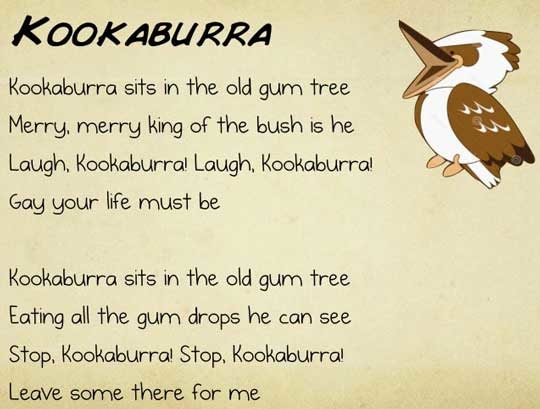|
Today's awesome animal is not one that makes an appearance in my novels, but it is one I've been thinking I should feature, especially since Trish and I saw so many of them on our Australia trip. Sometimes people can't resist describing certain animals as having personality. Well, the kookaburra is one of those that would definitely fall into the personality category. So what the heck is a Kookaburra? Kookaburras are birds in the kingfisher family. They are the largest of the kingfishers, growing up to 17 inches (42 cm) long. There are four species of kookaburras, the most well-known of which is the laughing kookaburra. The kookaburra, like the wombat and the kangaroo, is an iconic animal of Australia, and it is worth knowing more about. Here is a laughing kookaburra Trish and I saw while on a walk: Amazing facts about the Kookaburra Perhaps the most striking characteristic of kingfishers is their vocalizations, and the kookaburra is king (and queen) of the kingfishers in this respect. The laughing kookaburra (which is the species we saw in northeast Queensland) is famous for its astoundingly-loud "laughing" call. On our trip to Australia, even if we had wanted to sleep past daybreak, the kookaburras would not have allowed it. At first light, they seem to get the overwhelming urge to let everything within a half mile know that they still haven't lost their sense of humor. Because of their regularity, they are sometimes called the bushman's clock. Check out this video of a kookaburra laughing. And this one! Of course, they aren't really laughing when they do this. Instead, they are letting other birds know the boundaries of their territory. Kingfishers, in general, are territorial. The kookaburra is a predator with an impressive, boat-shaped beak, up to four inches (10 cm) long. Although most of the other species of kingfishers live near water and prey on fish, kookaburras often live far from water, and they typically kill and eat insects, lizards, frogs, snakes (even venomous snakes), rodents, and smaller birds. Here's one with a frog. Kookaburras are cool birds, but some Australian farmers aren't too fond of them because kookaburras have a fondness for killing and eating baby chicks and ducklings. It's a family affair. Kookaburras are monogamous (they choose one mate and stick together for a long time). They make their nests in holes in trees, laying up to five eggs. The eggs and hatched young are cared for not only by the parents but also by some of the siblings from previous clutches of eggs. So there could be seven or more kookaburras taking care of the young. Many of these sibling helpers will stay around to help for four years. These family groups get together each dawn and dusk and let out their loud, raucous calls to mark their territory. Kookaburras hunt by sitting perfectly still on a branch and watching for prey. But sometimes a breeze will make the branch sway. No problem. Kookaburras are capable of keeping their heads perfectly still while the branch moves so that they can better spot small movements on the ground. This motionless head and swaying body make them look like a reverse bobblehead. I grew up in Kansas, in the center of the US, thousands of miles from where kookaburras live. Yet I remember in school we would learn and sing the song, Kookaburra. This is a popular nursery rhyme and round, which apparently is taught to children around the world. It was written in 1932 by Marion Sinclair, a music teacher in Melbourne. As harmless as this song seems, its history has included considerable controversy. For example, in 2009, Larrikin Music (the copyright holder of the song) sued the Australian band Men at Work, claiming that part of the song Down Under (the flute portion) was a rip-off of the Kookaburra song. After almost a year, the court ruled against Men at Work. And then, in 2010, there was a big social media controversy when a primary school directory told students to change the words, "Gay your life must be" to "Fun your life must be." Now, when you look for the lyrics, you'll find a variety of different lines ("What a life you lead," "Sing your song for me," and others). So, the Kookaburra deserves a place in the D.A.H.O.F. (Dynamite Animal Hall of Fame). FUN FACT: The word dynamite was first introduced by A.B. Nobel, who invented dynamite. At some point in the 20th century, the word became a popular expression for anything spectacular. This use of the word is no doubt best known from the TV show, Good Times (1974 to 1979). In every episode, the character J.J. (played by Jimmy Walker) would say, "Dy-no-mite!" So, dynamite is another way to say awesome! Photo Credits:
Laughing Kookaburra #1 - Stan C. Smith Kookaburras with Frog - Richard Taylor, Wikimedia Commons Young Kookaburras - Tilgate Nature Centre Kookaburra Song - West View Music Lessons
0 Comments
Leave a Reply. |
Stan's Cogitations
Everyone needs a creative outlet. That's why I write. Archives
July 2024
|





 RSS Feed
RSS Feed